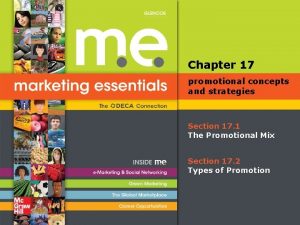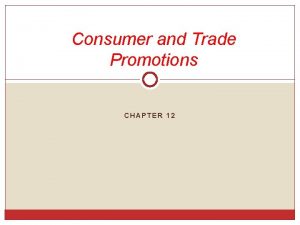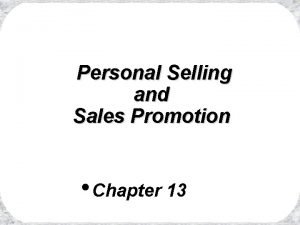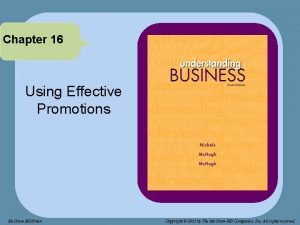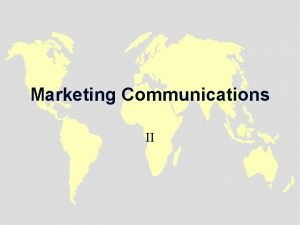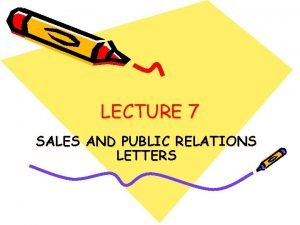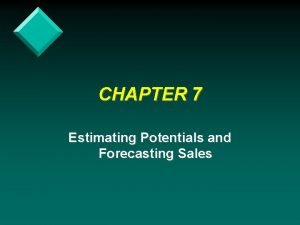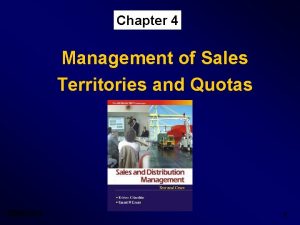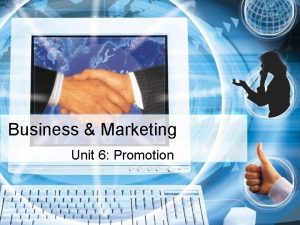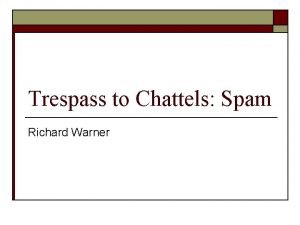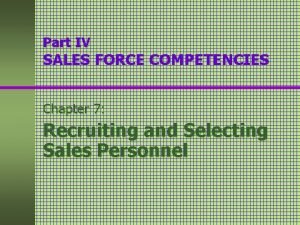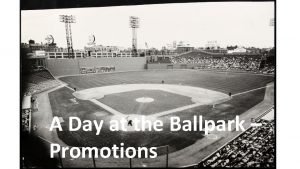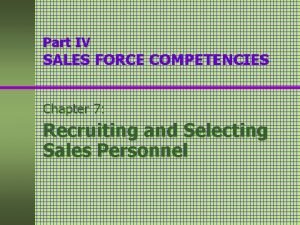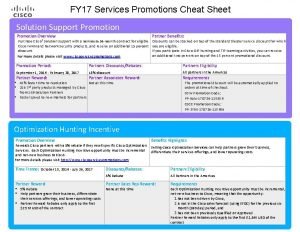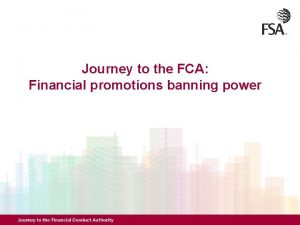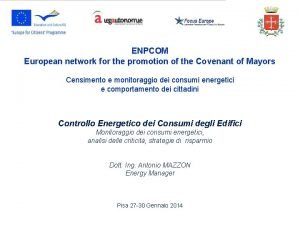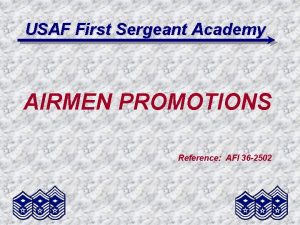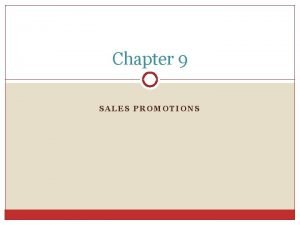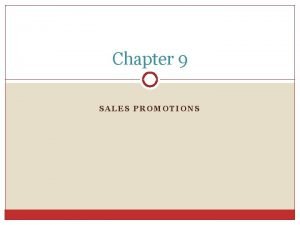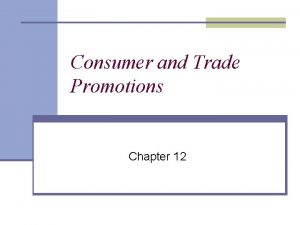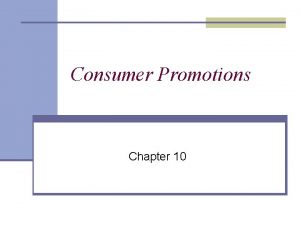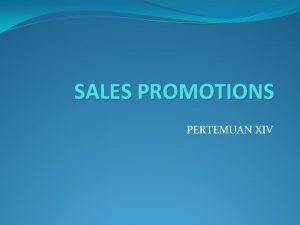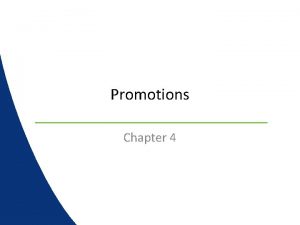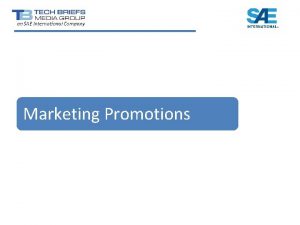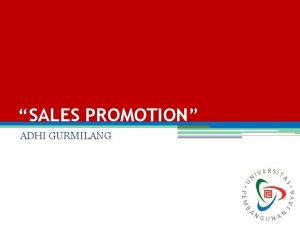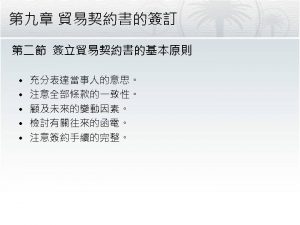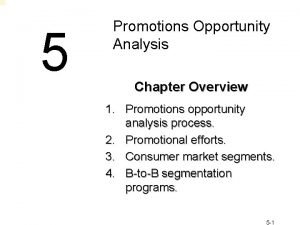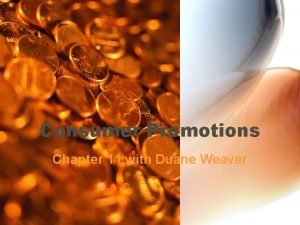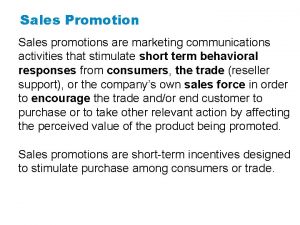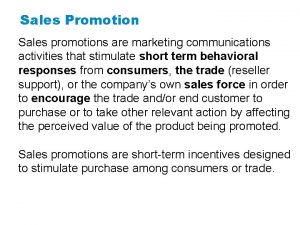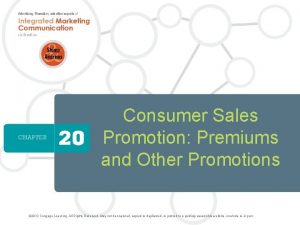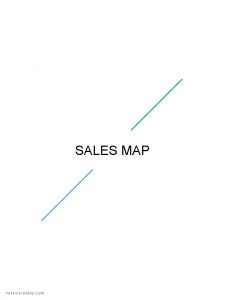Sales Promotions Chapter 12 Chapter Overview Consumer promotions
































- Slides: 32

Sales Promotions Chapter 12

Chapter Overview • Consumer promotions § Directed to individuals/ businesses that use product • Trade promotions § Directed to channel members • Can differentiate a brand • Use varies – product life cycle

Push/Pull Promotions Manufacturer Wholesaler/ distributors Retailers Pull: aimed at consumers – consumer promotions Consumers Push: aimed at channel members – trade promotions

Consumer Promotions • • Coupons Premiums Contests and sweepstakes Refunds and rebates Sampling Bonus packs Price-offs

Coupons • • Over 188 billion distributed Less than 1% redeemed Averagevalue ~ $1. 50 Savings of$2. 25 billion

Coupon Usage • Coupon usage § 80% of households use § 67% willing to switch brands • • Always ~ 21% Sometimes ~ 37% Rarely ~ 17% Never ~ 25%

Influencing Brand Purchases On a scale of 1 to 10, the following are the top five influences on the brand purchased by a consumer. • • • Sampling Word-of-mouth Coupons Advertising Contests 7. 8 7. 2 5. 9 5. 6 1. 2 Source: The Second Annual Survey of Consumer Preferences for Product Sampling, Santella & Associates (Http: //www. santella. com/marketing. htm).

Types of Coupons • Instant redemption § Lead to trial purchase • Bounce back § Encourage repeat purchase • Scanner-delivered § Encourage brand switching § Cross-ruffing

Coupon Distribution • Manufacturers issue about 80% • Freestanding inserts – 88% • Freestanding and print most popular § Createbrandawareness § Encourage next trip purchase • Digital coupons growing § Users more affluent, better educated

Coupon Distribution • Print media (90%) § FSI (88%) • Direct mail • On- or in-package • In-store § Scanner-delivered • Digital • Employee/Sales staff

Percentage of Sales with a Coupon Product category % of sales using manufacturer’s coupon Disposable diapers ~17% Detergents ~15% Meal starters ~14% Dough products (refrigerated)~14% Cereal ~13% Wrapping materials, bags ~13% Oral hygiene products ~12% Household cleaners ~12%

Coupon Redemption Rates Type of coupon • • Instant redeemable Bounce-back, In-Pack Electronic shelf Instantredeemable – cross ruff On-pack Direct mail Handout Free-standing inserts Source: Santella & Associates Percent Redeemed ~39% ~23% ~18% ~17% ~5% ~4% ~3% ~1%

Problems with Coupons • Reducedrevenues • Used by brand preference consumers (80 %) • “Necessaryevil”

Premiums • • Free-in-the-mail In- or on-package Store or manufacturer Self-liquidating • Don’t expect premiums to increase short-term profits

Contests and Sweepstakes • Contests § Require activity, skill § Can require purchase • Sweepstakes § § Random chance Must publish odds Cannot require purchase Enter as many times as desired

Refunds and Rebates • • • Refunds – soft goods Rebates – hard goods Hassle to redeem Now expected by consumers Redemption rates § 30% overall § 65% for rebates over $50

Sampling • • • In-store distribution Direct sampling Response sampling Cross-ruff sampling Professional sampling • 33% who tried a sample made a purchase during same shopping trip • 58% would buy product again • 25% bought product instead of intended brand

Benefits of Sampling Target specific markets/audience! • • • Introducenew products Encourage trial Generateleads Collectinformation Boost sales

Bonus Packs • • • Increase usage of product Match or preempt competition May lead to stockpiling Develop customer loyalty Attract new users Encourage brand switching Typical bonus packs are special multi-packs or packages with extra 20 - 100 % of product.

Price-Offs Temporary price reduction Benefits: • • Stimulate sales Entice trial Reducescustomer financial risk Encourages brand switching, stockpiling Problems: • Negative impact on profit • Encourages price-sensitivity • Potential impact on brand image

Planning Consumer Promotion (Pull) Advertising vs. Sales Promotion • Advertising more profitable, high growth, and premium priced brands. • Sales Promotion significant in less popular, low growth, mid to lower priced brands.

Planning Consumer Promotion (Pull) Retailers’ incentive to participate: • • Increase store traffic Increase store sales Attract new customers Increase basket size

Trade Promotions (Push) • Types of trade promotions • • Trade allowances Trade contests Trade incentives Trade shows For manufacturers, trade promotions • • • Accounts for 70% of marketing budget Often 2 nd largest expense Accounts for 17. 4% of gross sales

Trade Allowances Trade allowances: financial incentives to channe members – may be passed on to other members of channel Types: • Off-invoice allowance § Price discount § 35% of all trade dollars • Slotting fees • Exit fees

Slotting & Exit Fees • Retailer justification § § Cost to add new products to inventory Requires shelf space Simplifies decision about new products Adds to bottom line • Manufacturer objections § Form of extortion § Divert money from advertising and marketing § Detrimental to small manufacturers 4% of retailers use exit fees, 82% use slotting fees

Trade Allowance Complications • Failure to pass allowances on to retail customers § Only occurs 52% of the time § Retailers like only one brand on-deal at a time • Forwardbuying § Pass savings on or pocket higher margin § Additional carrying costs • Diversion § Segmentation strategy nullified § Additional shipping costs

Trade Contests • • • Used to achievespecific salestargets. Funds known as “spiff money. ” Rewards can be prizes or cash. Can be designed for various channel members Some channel members do not allow trade contests because of possible conflict of interests.

Trade Incentives • Cooperative merchandising agreement Trade Incentives • Premium or bonus pack • Co-op advertising programs 12 -28

Cooperative Merchandising Agreement • Formal agreement • Popular with manufacturers § Retailer must perform marketing functions § Manufacturer maintains control § Longer-term commitments • Benefit retailers § Schedule calendar promotions

Cooperative Advertising • Manufacturer pays part of retailer’s costs • Retailer must follow specific guidelines § No competing brands • Retailers accrue monies § Amount is based on sales • Allows retailers to expand advertising • Manufacturers gain exposure in local markets

Trade Shows • Business to Business venue § Consumer & Bt. B goods • Few deals finalized • Increasein internationalshows • National shows being replaced by regional and niche shows • Nicheshows § better prospects, Lower costs

Trade Shows - Attendees • • • Education seekers Reinforcement seekers Solution seekers Buying teams Power buyers Competitive interests
 Contrast trade promotions and consumer sales promotions.
Contrast trade promotions and consumer sales promotions. Food chain names
Food chain names Cross ruff sampling
Cross ruff sampling Sales promotion methods
Sales promotion methods Prodeploy enterprise suite sales overview
Prodeploy enterprise suite sales overview Herbivore animals in the ocean
Herbivore animals in the ocean Consumer diversity in consumer behaviour
Consumer diversity in consumer behaviour Consumer behaviour research process
Consumer behaviour research process Chapter 5 consumer markets and buyer behavior
Chapter 5 consumer markets and buyer behavior Chapter 5 consumer markets and buyer behavior
Chapter 5 consumer markets and buyer behavior Chapter 16 using effective promotions
Chapter 16 using effective promotions Sales promotion vehicles
Sales promotion vehicles Sales organization structure and sales force deployment
Sales organization structure and sales force deployment Difference between sales letter and sales promotion letter
Difference between sales letter and sales promotion letter Sales potential vs sales forecast
Sales potential vs sales forecast Pengertian sales force
Pengertian sales force Sales territories and sales quotas
Sales territories and sales quotas Role of imc
Role of imc Business promotions
Business promotions Compuserve v cyber promotions
Compuserve v cyber promotions Isagenix pib bonuses
Isagenix pib bonuses Nnn promotions interview questions
Nnn promotions interview questions Bill veeck promotions
Bill veeck promotions Randolph brooks credit card
Randolph brooks credit card Private equity
Private equity Nnn promotions interview questions
Nnn promotions interview questions Business promotions
Business promotions Cisco promotions 2018
Cisco promotions 2018 Nnn promotions interview questions
Nnn promotions interview questions Business promotions
Business promotions Fca financial promotions
Fca financial promotions Promotions ddg heating
Promotions ddg heating First sergeant afi
First sergeant afi
